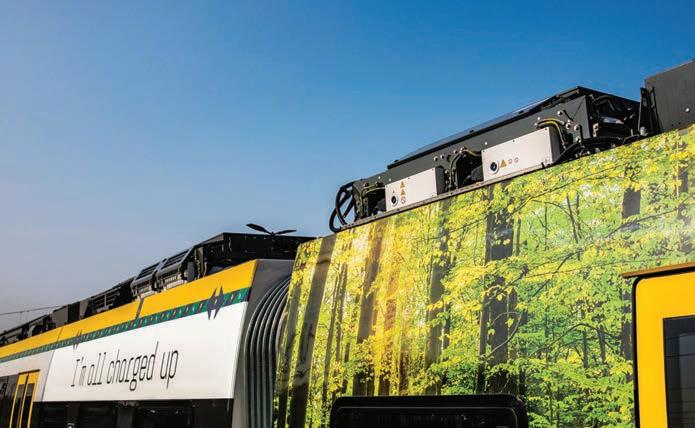
4 minute read
Bombardier’s new battery electric train
from Rex Jun 2020
by Prime Group
The Bombardier TALENT 3 train.
Filling the gap
Bombardier is helping rail operators achieve zero emissions on unelectrified track with its battery electric units while slashing lifecycle costs.
One of the key benefits of rail travel to the community is its low emissions. Whether powered via overhead lines or an electrified rail, trains offer fast, high volume mobility, and if powered by renewable energy, emissions free. That is, until the wire runs out.
In Australia, nationally there is 36,064 kilometres of track, but only a small portion of that in the major cities has an overhead power supply. In New Zealand, out of the total 4,128 kilometres of track, 589km is electrified. As the non-electrified sections of the network are often outside of major urban centres, getting regional travellers to travel by train presents the issue of running higher emitting vehicles, or undertaking costly electrification works on lines that have fewer services. These factors present an impediment to the zero emissions potential of rail transport, however one that is recently being overcome.
Launched in 2018, the Bombardier TALENT 3 train is a battery-electric multiple unit to fill the gap in-between electrification of entire rail networks and continued reliance on diesel-powered units. The TALENT 3 train can provide an operator with a 30 per cent reduction in the total cost of ownership, when compared to a conventional diesel multiple unit over a 30-year service life.
The train is powered by Bombardier MITRAC traction batteries and can run on non-electrified lines for distances of up to 100km. The batteries utilise recent technological innovation in fast charging and high-density lithium ion batteries which can be charged in less than 10 minutes while running on an electrified section of track, or through recuperating otherwise lost
The trains are powered by Bombardier’s MITRAC propulsion system.
energy when the train is braking.
The research and development work that went into the TALENT 3 train was supported by the German federal government, research institutions, and regional German transport operators. Additionally, the technology behind the train was developed by Bombardier in its Mannheim laboratory in Germany. The newly inaugurated €1 million ($1.72m) facility contributed to the battery

The system’s innovation has been recognised in design awards.
components for the TALENT 3 train. In Europe, the demand for battery electric units is increasing, as shown in recent orders for trials of the trains in multiple countries.
In Germany, the innovation involved in the development and production of the TALENT 3 train was recognised in late 2018, when Bombardier won the Berlin Brandenburg innovation award. In particular the jury singled out the role that battery electric trains could provide to Germany’s non electrified network. The train could already operate on 30 per cent of the country’s non-electrified lines, and if costeffective electrification was done at end points, 75 per cent of lines that currently run diesel-powered services could be operated with battery power.
Commenting on the project, Bombardier’s head of sales – Australia and New Zealand, Todd Garvey, highlighted how the train would overcome network limitations.
“It was Bombardier’s goal to develop a quiet and eco-friendly train for passengers, while also offering operators the best alternative to higher emittting diesel trains on both cost and safety aspects.”
In Australia and New Zealand, where there are already proposals for the electrification of sections of regional and intercity track, the Bombardier TALENT 3 train could readily operate on lines such as the Hunter Line,

Todd Garvey, head of sales – Australia and New Zealand at Bombardier Transportation
a variety of V/Line services in Victoria, and partially electrified sections of track in New Zealand. However, the flexibility of batteryelectric trains enables new connections to be made.
“The BEMU – as we call it – has massive potential in the ANZ market as the cost barriers to deploy widescale electrification are considerable.
“Our BEMU provides operators and governments with a zero-emission alternative to diesel propelled vehicles across their extended networks. Once the electric line runs out, the batteries kick in and the vehicle can continue running as normal for up to 100 kilometres.
“The only additional infrastructure then would be strategically placed charging stations throughout the regional network that the vehicle can plug into, to recharge the battery,” said Garvey.
“This presents big savings and reduces the need for a large-scale civil works program. These battery trains are also quieter, and this is good in greenfield residential areas, for example, where diesel trains might not be the preferred option.”
The key to realising the benefits of battery trains is their flexibility. Not only do they reduce a network’s total emissions but eliminate the immediate impact of emissions caused by the trains themselves. Emissions from diesel powered vehicles can limit their use in inner city areas and confined spaces such as tunnels. In addition, Bombardier’s TALENT 3 can achieve a significant reduction in noise, when compared to conventional DMUs.
Combining the latest in battery technology and a pedigree of innovation, the TALENT 3 provides zero emissions mobility to a much wider audience.










